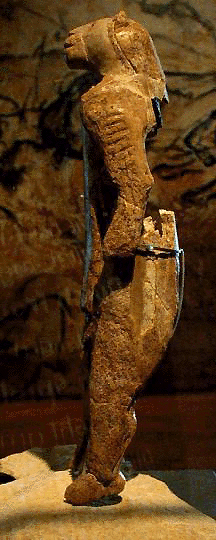32,000 Year Old Relic a Nrsimhadeva Idol?
BY: SUN STAFF

Löwenmensch
Upper Paleolithic, c. 30,000 B.C.
May 28, 2012 — CANADA (SUN) —
Many news stories about prehistoric finds and their possible meaning in terms of archaeology and social history have reached the world in recent decades. One of them, found in South Germany, put scientists around the world in a state of amazement some years back. The centerpiece is the "lion man", an idol that is made from the tusk of a mammoth in the form of a human body with a lion head. Amazingly it is dated to be 32,000 years old.
This discovery generated a lot of attention in the archaeological circles of Europe. In excavations around 1930-35 at the Lonetal area near Ulm, Germany, scientist discovered an immense jurassic cave system with lots of prehistoric artifacts in it. At first, only representations of birds, horses, turtles and single lions where found, but no morphological combinations of men and animal, so the "lion man" was quite outstanding and unique. It also became clear during later examinations that the "lion-men", the biggest and most spectacular of the ivory figures excavated, was used for ritual purposes, unlike the other items.
The pieces of "Löwenmensch" were found in 1939 in a cave named Stadel-Höhle im Hohlenstein (Stadel cave in Hohlenstein Mountain, also called Hohlenstein-Stadel cave), in the Lonetal (Lone Valley) of the Swabian Alps, Germany. With the start of the Second World War demanding world attention, the artifact was forgotten, and only rediscovered thirty years later. The first reconstruction revealed a humanoid figurine without a head, but between 1997 and 1998, additional pieces of the sculpture were discovered and the head was reassembled and restored.
The figure was found exactly at the place in the cave where day and night meet, about 20 meters away from the entrance and buried 1,20 meter deep under the ground. Many parts of the figure were broken and where found a little distance away in the area. Therefore it took some time to finish the work of completing and reconstructing the figure and to see it as a whole.
As Vedic sastra tells us, Lord Vishnu appeared in the divine form of a half-man, half-lion with a lion face, Appearing to protect His devotee Prahlad and to stop irreligion, personified by the demon Hiranyakasipu. A description of a standing Deity form of Nrsimha Avatara of the Lord is found in the agama Silpa Shastra, and is referred to as kevala-narasimha.

In India there are many ancient temples in which the Deities of Sri Narasimha Bhagavan reside and are worshiped. Many are located in special tirthas, high up on mountain peaks or deep in caves.
Many other ancient cultures had idols or pictures of divine lion-like personalities with a human face or torso, that may also have their origin in Nrsimhadeva. For example, Egypt has the Sphinx and the war-like Sekhmetm; Persia has the Sun god Mithra, the Assyrians have the Gate Guardians of Babylon, and the Etruscan lion with wings stands at the entrance of the Temple mountain at Troy.
The winged man-lion idols are sometimes said to be associated with the Gandaberunda form of Narasimhadev, a two-headed bird form that Nrsimhadeva took while fighting with Shiva in his Sharabha (bird) form.
The great discovery in Lonetal of the man-lion idol was found in a deep cave, situated northeast towards the River Lone. At this point, Indologists and experts in proto-Vedic archeology have no proof that this idol is, in fact, Lord Narasimhadev, but with the sculpture now available for exhibition, perhaps other evidence will come to the fore, matching this form to other ancient depictions of the Visnu Avatara, our worshipable Nrisimha.
Adaptation of articles from Wiki and Global Hinduism.com
